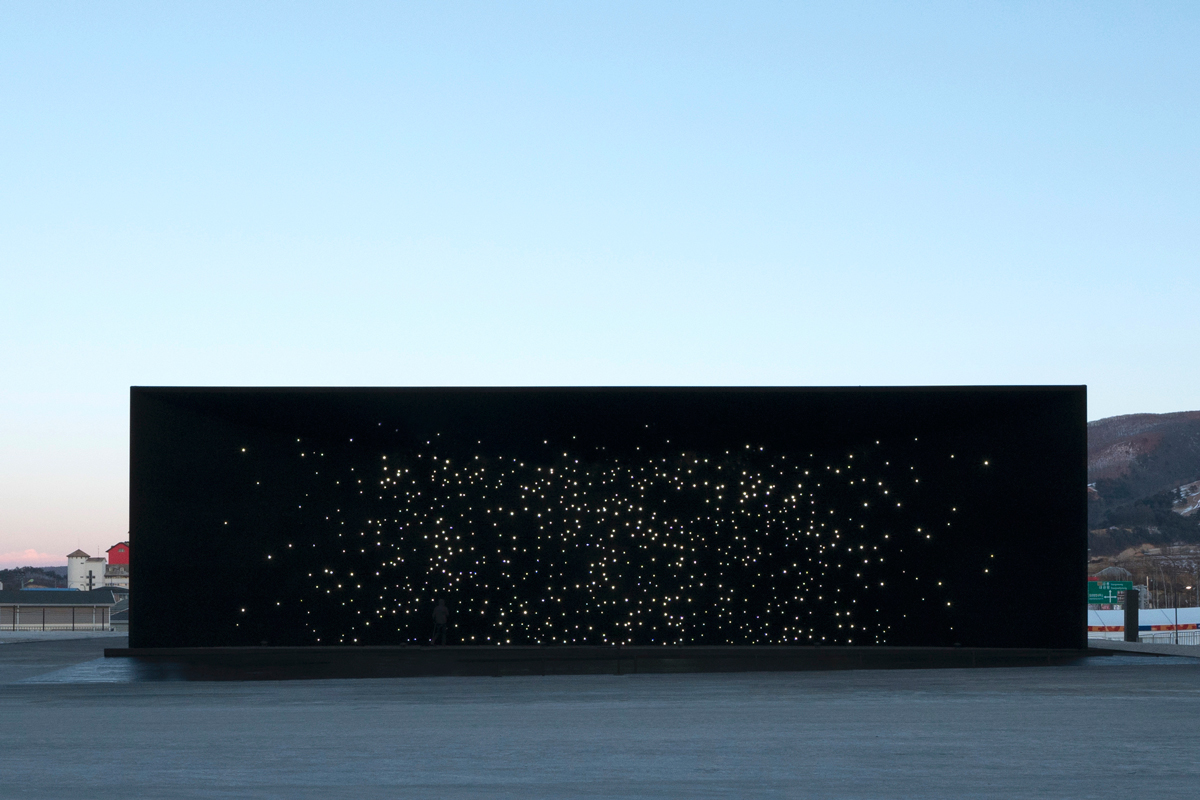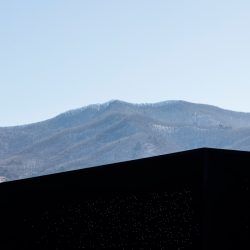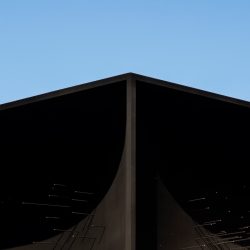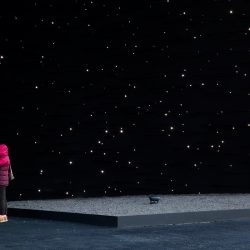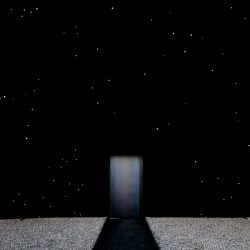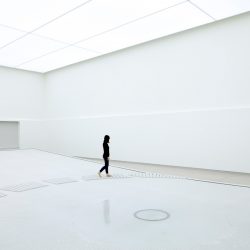IT HAS BECOME SOMEWHAT OF A CUSTOM FOR LARGE-SCALE FESTIVALS WITH THE MASS VOLUMES OF SPECTATORS TO FEATURE NEWLY BUILT STRUCTURES
commissioned by big corporations and, as the event attracts a bigger audience, the commissioners get to promote their brands. PyeongChang Winter Olympic Games jumped on this bandwagon because in addition to the sports, the snowy town welcomed Hyundai Pavilion, the self-proclaimed ‘darkest building on the planet’ designed by British architect, Asif Khan.
Vantablack VBx2 is the origin of the building’s nickname, with the term being used to name the black color developed by a group of scientists called Surrey NanoSystems who took Anish Kapoor’s Vantablack to another level of darkness. The molecules of the pigment were made smaller so as to be at a micro level, allowing for the pigment to be sprayable. In 2013, Asif Khan started to contact Surrey NanoSystems before eventually using the color on the four curved walls of the pavilion. The blackness of Vantablack VBx2 can absorb 99% of light, causing the curved angle of the walls to be undetectable visually, and as a result, creating an illusion where the walls collectively appear as if a massive void is opening to a different physical space. Asif Khan made use of such effect by creating a simulated universe with thousands of pinpricks of light installed on the wall, transforming the black walls into a starlit universe.
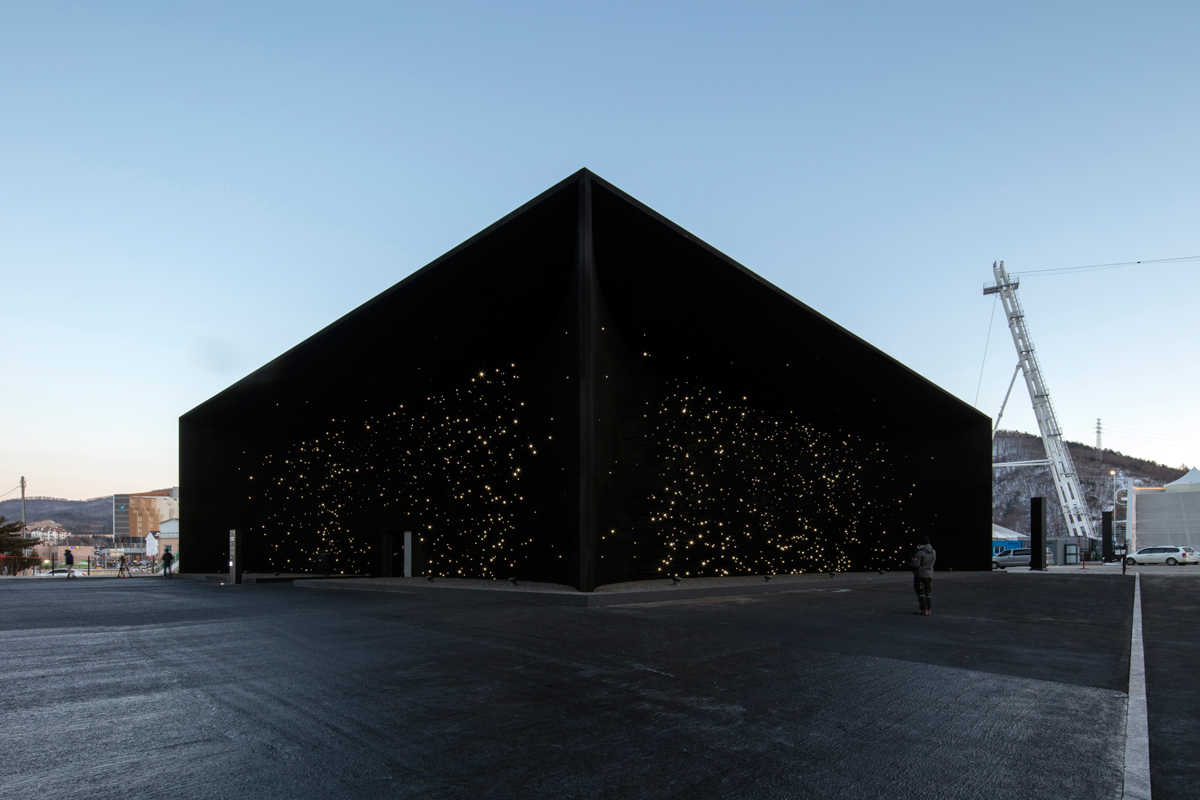
In great contrast with the exterior, the inside of the pavilion was made to be of a bright white. The ‘Water Room’ houses a large-scale installation inspired by Hyundai’s launch of hydrogen fuel technology. The stark contrast between the exterior and interior is the result of one of Asif Khan’s intentions to shock viewers with the interconnected scales of the universe and the tiny mass of the water droplet experienced by a walk around the pavilion. Water was used for it’s the primary component of hydrogen and most giant planets are composed predominantly of hydrogen.
ตอนนี้เป็นธรรมเนียมไปแล้วว่าเทศกาลอะไรก็ตามที่คนมาเยอะๆ บรรดาธุรกิจรายใหญ่ๆ ต้องถือโอกาสลงทุนสร้างอะไรสักอย่างเพื่อเป็นการประชาสัมพันธ์ตัวเอง เช่นเดียวกับใน PyeongChang Winter Olympic Games ปีนี้ที่นอกจากจะมีกีฬาให้ดู ท่ามกลางเมืองที่ขาวโพลนไปด้วยหิมะก็ยังมี Hyundai Pavilion อาคารที่มีชื่อเล่นว่า ‘อาคารที่ดำที่สุดในโลก’ ที่ออกแบบโดย Asif Khan สถาปนิกชาวสหราชอาณาจักร ให้ได้เข้าไปเยี่ยมชมกันด้วย
Vantablack VBx2 เป็นที่มาของชื่อเล่นที่ว่า โดยเป็นชื่อของสีดำาที่ถูกพัฒนาโดยกลุ่มนักวิทยาศาสตร์ชื่อ Surrey NanoSystems ที่นำา Vantablack ของ Anish Kapoor มาพัฒนาให้โมเลกุลของสีเล็กลงในระดับไมโครจนสามารถใช้กับเครื่องพ่นสีได้ ในปี 2013 Asif Khan เริ่มติดต่อกับนักวิทยาศาสตร์กลุ่มนี้ ก่อนที่ช่วงต้นปีที่ผ่านมาสีดำชนิดนี้จะถูกนำมาใช้พ่นผนังโค้งเว้าของพาวิลเลียนทั้ง 4 ด้าน ความดำาของ Vantablack VBx2 ที่ดูดซับแสงได้ถึง 99 เปอร์เซ็นต์ ทำให้สายตาของคนดูแทบจะจับความโค้งของผนังไม่ได้ และเกิดภาพลวงตาคล้ายๆ กับว่าผนังทั้งหมดเป็นช่องขนาดใหญ่เปิดไปสู่อีกพื้นที่หนึ่ง และ Asif Khan ก็ใช้ประโยชน์จากเอฟเฟ็คต์นี้สร้างจักรวาลจำลองขึ้นมา ด้วยการติดไฟดวงเล็กๆ นับพันดวงบนผนัง เพื่อเปลี่ยนให้การมองผนังดำาธรรมดาๆ กลายเป็นประสบการณ์การมองออกไปยังอวกาศ
ตัดกันกับภายนอก ภายในพาวิลเลียนถูกทำาให้ขาวโพลนไปทั้งห้อง โดยเฉพาะใน ‘Water Room’ ที่ติดตั้งอินสตอลเลชั่นขนาดใหญ่ที่พูดถึงเรื่องไฮโดรเจนซึ่งเป็นเทคโนโลยีเชื้อเพลิงสะอาดของ Hyundai ความแตกต่างกันอย่างสุดขั้วของภายนอก / ภายในเป็นสิ่งที่ Asif Khan ต้องการ เขาบอกว่าเขาต้องการช็อกคนดูด้วยการเชื่อมโยงสเกลจักรวาล มายังอณูเล็กๆ ของหยดน้ำด้วยการเดินไม่กี่ก้าวเข้ามาในพาวิลเลียน ส่วนสาเหตุที่ต้องเป็นน้ำนั้นก็เพราะน้ำเป็นองค์ประกอบสำคัญของไฮโดรเจน และไฮโดรเจนก็เป็นองค์ประกอบสำคัญของดาวเคราะห์นั่นเอง
TEXT : NAPAT CHARITBUTRA
PHOTO : LUKE HAYES
asif-khan.com

